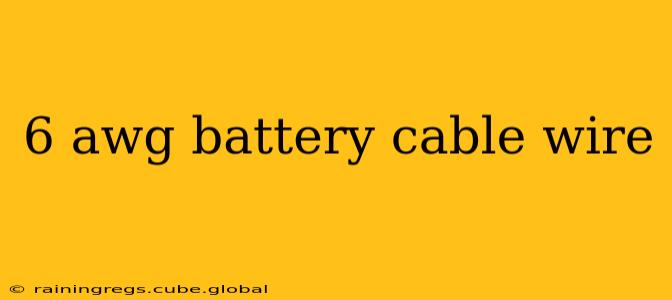6 AWG (American Wire Gauge) battery cable is a popular choice for high-current applications, particularly in automotive, marine, and power systems. Its thicker gauge signifies a larger diameter, allowing for significant current flow with minimal voltage drop. This guide delves into the specifics of 6 AWG battery cable, covering its uses, capabilities, and considerations for choosing the right cable for your needs.
What is 6 AWG Battery Cable Used For?
6 AWG battery cable is designed to handle substantial amperage, making it ideal for applications demanding high power transfer. Common uses include:
- Automotive applications: Connecting batteries to high-draw components like starters, alternators, and powerful audio systems. Its robust construction ensures reliable power delivery even under demanding conditions.
- Marine applications: Powering trolling motors, winches, and other high-current devices on boats. Marine-grade 6 AWG cable is often constructed with materials resistant to corrosion and UV degradation.
- RV and camper applications: Providing reliable power to appliances and systems in recreational vehicles. This is crucial for ensuring consistent functionality while off-grid.
- Welding equipment: Supplying power to welding machines, which require substantial current for operation.
- Solar power systems: Connecting solar panels to charge controllers and battery banks. Properly sized cable minimizes energy loss during transfer.
- Backup power systems: Ensuring reliable power delivery during outages.
How Much Current Can 6 AWG Battery Cable Handle?
The amperage capacity of 6 AWG battery cable isn't a fixed number. It depends heavily on several factors including:
- Insulation type: Different insulation materials have different heat tolerances, affecting the maximum safe current.
- Ambient temperature: Higher temperatures reduce the cable's current-carrying capacity.
- Installation method: Bundling multiple cables together increases heat buildup, reducing capacity.
- Length of the cable run: Longer runs increase resistance and voltage drop, necessitating careful consideration of cable size.
While a general guideline might suggest a capacity in the hundreds of amps, consulting the manufacturer's specifications for your specific cable is crucial to ensure safe and reliable operation. Overloading the cable can lead to overheating, melting insulation, and potential fire hazards.
What is the difference between 6 AWG and 4 AWG battery cable?
The key difference lies in the gauge size—4 AWG is thicker than 6 AWG, meaning it can handle significantly higher amperage. The choice between them depends entirely on the current demands of your application. If you're unsure, it’s always better to err on the side of caution and choose the larger gauge.
What type of connectors are compatible with 6 AWG battery cable?
6 AWG cable requires appropriately sized connectors to maintain a secure and reliable connection. Common connector types include ring terminals, lug terminals, and Anderson Powerpoles, amongst others. Always ensure that the connectors are rated for the same or higher amperage as the cable itself.
How long can a 6 AWG battery cable run be?
The maximum length of a 6 AWG battery cable run depends on the required amperage and acceptable voltage drop. A longer run will result in higher voltage drop, reducing the efficiency of the system. Consult voltage drop calculators or seek professional advice to determine the appropriate cable length for your specific application.
What are the safety precautions when using 6 AWG battery cable?
- Always use the correct gauge and type of cable for your application. Improperly sized cable can lead to overheating and fire hazards.
- Ensure proper insulation and secure connections. Damaged insulation or loose connections can create short circuits.
- Use appropriate safety equipment. When working with high-current systems, wear gloves and eye protection.
- Never overload the cable. Operating the cable beyond its rated capacity is dangerous.
- Follow manufacturer's instructions. Consult the cable manufacturer's specifications for safe installation and operation.
By carefully considering these factors and following safe practices, you can effectively utilize 6 AWG battery cable in various high-power applications. Remember to prioritize safety and always consult professional guidance when needed.
